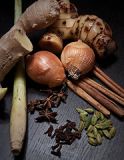Spa Cuisine Of Indonesia
 Spices such as nutmeg, clove and pepper were the main reason traders from China, India and Arabia were drawn to Indonesia in the early days These spices also attracted European Traders in the 1500s, who by then had begun to use them for their medicinal properties and as food preservatives. The Indonesians were influenced not only by these traders’ religious beliefs and traditions, but also by their cuisine. Satay is most likely a reinterpretation of the kebab, a dish introduced by Arab traders. The Arabs’ religious beliefs also led to the importance of goat and lamb as meats in Indonesia – pork being forbidden and served only where the community is predominantly either Chinese or Hindu. Stir-fried dishes, and the use of the wok as a kitchen utensil, are no doubt the result of Chinese influence. Like Indian cuisine, Indonesian cuisine also involves the use of the pestle and mortar to grind spices into a fine paste which is then fried to release their aroma and flavor. Many of the spices used in Indonesian cooking are also common to other cuisines. For instance, shrimp paste is also used in Thailand, Vitenam and Philippines. Turmeric, root ginger and cumin are important spices in Indian cuisine, while lemon grass and coriander are commonly used in Thai dishes. All can be found in Indonesian dishes. Despite the amalgam of influences, Indonesian cuisine is immediately recognizable. Rice is a staple, as in other Southeast Asian countries. Meat, fish and vegetables are condiments meant to flavor the staple. Hot dishes, coconut milk and spices are a must, although they are used in differing amounts in different parts of Indonesia.
Spices such as nutmeg, clove and pepper were the main reason traders from China, India and Arabia were drawn to Indonesia in the early days These spices also attracted European Traders in the 1500s, who by then had begun to use them for their medicinal properties and as food preservatives. The Indonesians were influenced not only by these traders’ religious beliefs and traditions, but also by their cuisine. Satay is most likely a reinterpretation of the kebab, a dish introduced by Arab traders. The Arabs’ religious beliefs also led to the importance of goat and lamb as meats in Indonesia – pork being forbidden and served only where the community is predominantly either Chinese or Hindu. Stir-fried dishes, and the use of the wok as a kitchen utensil, are no doubt the result of Chinese influence. Like Indian cuisine, Indonesian cuisine also involves the use of the pestle and mortar to grind spices into a fine paste which is then fried to release their aroma and flavor. Many of the spices used in Indonesian cooking are also common to other cuisines. For instance, shrimp paste is also used in Thailand, Vitenam and Philippines. Turmeric, root ginger and cumin are important spices in Indian cuisine, while lemon grass and coriander are commonly used in Thai dishes. All can be found in Indonesian dishes. Despite the amalgam of influences, Indonesian cuisine is immediately recognizable. Rice is a staple, as in other Southeast Asian countries. Meat, fish and vegetables are condiments meant to flavor the staple. Hot dishes, coconut milk and spices are a must, although they are used in differing amounts in different parts of Indonesia.